[Updated December 26, 2018]
In some training circles, it’s still a sacred cow: the idea that the only way to get a dog trained to near perfection and utter reliability is to teach him that he “has to” comply; it doesn’t matter if he “wants to.” Adherents of this school of training believe that in order to create a dog who responds reliably when first “commanded,” force-based training techniques must be used.
Fortunately, more and more trainers are realizing this sacred cow is a bunch of bull.
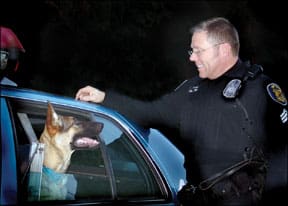
Positive reinforcement training has made significant inroads among much of the dog-owning population. However, many handlers involved in precision-based sports such as field work, obedience, and Schutzhund, along with many pet owners of “strong” breeds such as Rottweilers, Dobermans, and so-called “bully” breeds, still believe a healthy dose of compulsion is necessary to convince the dog he must perform as “commanded” (as opposed to “cued” or “requested”).
The trainers of working police dogs generally feel that their dogs – and their jobs – also require the use of force-based techniques; a majority of law enforcement dog handlers still rely on compulsion. Fortunately, a growing number are beginning to realize that positive reinforcement not only produces reliable dogs, it also decreases dog-handler conflict and creates stronger working relationships.
Among the “serve and protect” leaders of the movement toward positive training is Seattle-based trainer Steve White. A sergeant with the Seattle Police Department, White has more than 35 years of experience as a canine handler.
White’s early dog training experiences were spent in the U.S. Army as a patrol dog handler at Lackland Air Force Base, a joint forces military installation in San Antonio, Texas. At the time, military dog training methods were based largely on the early work of Col. Konrad Most and William Koehler, and can best be described as a “carrots and sticks” approach.
“They taught us to praise our dogs by making us face and praise a rock,” White says. “They made you stand at your rock, get goofy and excited . . . ‘That’s a good boy, that’s a good dog, that’s a good baby!’ At the same time you were practicing praising your rock, you were practicing leash corrections on a chain link fence. You got both sides of it.”
Most behaviors were taught using negative reinforcement, a technique where the handler applies physical or social pressure in an effort to coerce or force the dog to alter his behavior – for example, pushing on a dog’s backside to elicit a “sit” or using a collar and leash to drag a dog into a “down.” In both cases the dog learns that compliance relieves the pressure; he works to avoid the uncomfortable situation.
Punishment in Dog Training Creates Conflict
For many dogs, especially those who are deliberately selected for their high-drive personalities and strong physical and emotional make-up, these techniques routinely create a conflict between dog and handler that results in a bite.
For White, the bite came after working with “Astro,” his first canine partner. The dog was willing to acquiesce to sit and perform heelwork, but was all too ready to fight back when White attempted to force him into a “down.” In an intense battle of wills, White sustained a bite that sidelined his training for two weeks. He returned to work a different dog and went on to finish the program as a Distinguished Honor Graduate.
“(Getting bitten) was common enough that they taught you how to deal with it,” says White. “They taught you how to protect yourself . . . to string up a dog. If the dog came at you, you lifted up on the leash and kept the pointy end away from you until the dog stopped fighting. It wasn’t an act of training; it was an act of self-defense until the dog could no longer offer an offense.”
One of the dangers of punishment, aside from the potential for physical harm and its ability to erode the dog-handler relationship, is the tendency for the handler to escalate out of frustration or a misguided desire for revenge.
“They taught us how to “airplane” (the dogs) so that you picked them up and started to spin around so they’d be off balance and couldn’t come after you,” White explained. “Some dogs could withstand being suspended by their neck longer than your arms could stand keeping them up there and then what do you do? Some people would walk over to the nearest fence and suspend the leash from that and hold the dog up. That would get carried away because now that you aren’t getting tired, and you’re a little ticked off, some people would succumb to the temptation to keep the dog up there longer.”
Thankfully, according to White, this didn’t happen often at Lackland, but sadly, it does sometimes happen in the name of police canine “training.” In August 2007, then Trooper Sgt. Charles Jones of the North Carolina Highway Patrol was unknowingly videotaped by a fellow trooper as he hung his Belgian Malinois “Ricoh” from a railing and kicked him repeatedly for failure to release a training toy.
Photo by Senior Airman Christopher Griffin.
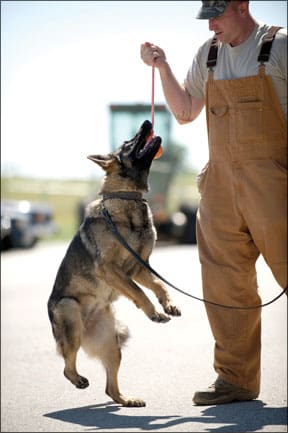
The video ended up on YouTube, sparking a public outcry that resulted in Jones losing his job. However, in November 2010, North Carolina Superior Court Judge James Hardin Jr. ruled that Jones was improperly fired and should be returned to his position as a canine officer, along with receiving back wages and attorney’s fees. The judge ruled that although Jones’ actions were not specifically part of the agency’s standard techniques, they were no worse than its accepted methods.
A similar video shows a Baltimore Police Department officer repeatedly lifting and throwing his canine partner to the ground in the name of training. For nearly three minutes, the officer battles with his dog while at least one bystander (assumed to be a supervisor or trainer) offers encouragement and instruction on how to show the dog “who’s boss.”
Another media report recounted how, in June 2006, a frustrated Miami-Dade Police Sergeant, Allen Cockfield, delivered a lethal kick to his canine partner, “Duke,” in an ill-fated training session.
A More Reliable Way to Train
Fortunately, early in his career, White realized there were better ways beyond the force- and fear-based methods of his first experience. In the mid 1970s he began exploring the works of Leon Whitney (author of Natural Method of Dog Training), Ray Berwick (How to Train Your Pet Like a Television Star) and Patricia Gail Burnham (Playtraining Your Dog). These three books served as a trilogy of concepts that was later supported by Karen Pryor’s Don’t Shoot the Dog, and set a path toward a training future based on positive reinforcement.
White’s first post-military canine assignment came with the Kitsap County Sheriff’s Office in Washington State, and he later joined the Seattle Police Department. He now also runs i2i K9 Professional Training Services, a consulting and training business operating out of Rivendale Learning Center, a “No Force – No Fear”® training company owned and operated by Steve and his wife, Jennifer.
White learned that one of the problems with negative reinforcement and punishment is the ability to create conflict, as his Army dog, Astro, so aptly demonstrated. He also learned that, conversely, positive reinforcement and negative punishment (removing access to what the dog wants following an incorrect response) are more likely to foster increased cooperation as the dog learns to trust the handler, and the team develops a stronger working relationship.
“With positive reinforcement training, you front load the effort,” White says. “There’s a lot of stuff to get the wheels turning. The curve is really steep in the beginning, but after a while it levels out and the workload is not as high. With negative reinforcement, you get full, finished behaviors quickly, but maintenance work afterward is high because the dog figures out the name of the game is ‘only work as hard as it takes to get this guy to leave me alone.’ With positive reinforcement, especially with substantial amounts of free-shaping, the dog figures the name of the game is ‘work as hard as I can to get this guy to pay off.’ The fundamental paradigm changes in the dog’s mind.”
Bob Eden shares White’s desire to transform police canine training. In 1991 Eden, a retired Delta Police Department (British Columbia, Canada) canine handler, founded the K9 Academy for Law Enforcement and the International Police K9 Conference, dedicated to positive reinforcement education for canine handlers around the world. With a team of 20 positive reinforcement-based instructors (including White), Eden’s organization demonstrates the effectiveness of positive reinforcement training to about 150 police agencies each year. Eden’s mission is inspired by the little-known fact that statistically, canine handlers are involved in more gunfights than any other members of their department as a result of the suspect-oriented work they do.
“My goal as a retired police officer is to make sure that police officers who work with dogs go home to their families at the end of their shifts,” Eden says. “I want to make sure your dog is a precision animal that you, as an officer, don’t have to worry about on the street. If I’ve got my dog in the car and I end up in a confrontation with a suspect, I don’t have to worry about what my dog is doing. My attention is not divided between my dog and the person I’m dealing with. When I’m telling my dog what I need to have done, I know it will happen because my foundation work has been good. A policeman cannot afford to be a dog trainer on the street.”
Train the Positive Police K9 Way
Whether training a strong-willed Shepherd or a creampuff Cavalier, the art and science of learning theory and behavior modification remains the same. White offers the following five tips designed to improve training results:
1. “For big results, you’ve got to think small. Always look for, and reinforce, the littlest increments on your way to the end behavior.”
A finished behavior is the sum of its parts. For example, when training acceptance of nail trimming, remember to start with basic foot handling — without clippers, and at a level your dog can tolerate. That might mean touching one toe, with one finger, for one second. Work up from there.
2. “Street-reliable skill sets are narrow and deep. Concentrate on fluency and generalization of the few behaviors you’ll need on the street.”
Watch out for the “jack of all
trades, master of none” phenomenon, where your dog can sort of do a lot of things, but lacks a solid performance in any of them.
3. “Over-train wisely. Build levels of fluency, generalization, and resistance to distraction beyond what you’ll need on the street.”
ln training classes, we practice stays while remote—controlled cars pulling miniature wagons filled with treats zoom past. If your dog can do that, he’s more likely to successfully handle sitting patiently as you prepare his dinner. Be creative in your training, but always work at a level that is fair to your dog.
4. “Failure is information. If the dog does not perform as expected, it’s just because you asked for something you have not yet fully trained.”
Remember that behavior change doesn’t happen overnight. Persistence, patience, and practice are key.
5. “If it ain’t fun, it ain’t done. As soon as training becomes a drudge for either end of the leash, stop, rest, and find ways to bring the joy back into it.”
Smart trainers know that dog training can – and should – be fun. Many pet training classes now use fun games like Hide & Seek and Red Light, Green Light to encourage a joyful, playful attitude while training. Good training should leave you and your dog wanting more, not feeling like it’s a bore and a chore!
“Emergency Brakes”
While White no longer uses punishment as a standard training technique, he offers an honest assessment of its use:
“Through the years, the more positive reinforcement I use, the fewer aversives I use,” he explains. “I’m not 100 percent pure positive; I sometimes need to use an emergency brake (such as a verbal reprimand or leash correction) – but I no longer use aversives as a teaching tool.”
No form of training will produce perfect dogs 100 percent of the time. In law enforcement, if a police dog makes a mistake, people (or the dog) can get hurt.
“Police dogs do something other dogs don’t,” White says. “They consummate the urge to bite, and then are asked to voluntarily stop something that is either highly reinforcing in a positive way by being fun, or negatively reinforcing by vanquishing a life-threatening adversary. It’s a demand that is unique to law enforcement and military dogs.”
When lives are on the line, if the dog fails to respond appropriately to a cue, handlers must have a way to stop the dog.
“Emergency brakes are just what the name implies – for emergencies only. They are not a training tool, but an emergency management tool.” says White.
Note: In pet dog training, whether it’s your walk-in-the-wood companion or your competition obedience star, if you find yourself frequently using aversives, it’s a strong indication that your reinforcement history is weak.
Shaping A Dog’s Behavior
Eden and White utilize the training principle of shaping, an operant conditioning technique where the dog is encouraged to discover (and then be rewarded for) the correct behavior on his own rather than physically manipulated or lured into the desired behavior. In the early stages, the handler’s job is simply to manage the training environment in a way that prevents the dog from self-rewarding undesired behavior. Eden calls this letting the dog teach himself.
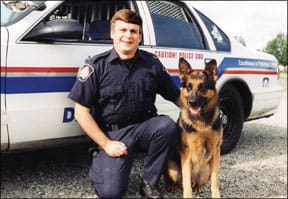
“If we get a dog into training that we allow to teach himself, the benefits are exponentially greater than what we had under the old system of negative reinforcers and compulsive training,” he says. “We found that it was so much better and the results were at the point where we had very little recidivism.”
Many trainers (both in law enforcement and the civilian world) maintain a strong belief that incorrect responses must quickly be corrected. Through shaping, Eden and White turn this concept on its head, setting up training scenarios so that the dog, who initially does not know what the correct response is, experiments with different behaviors in an attempt to earn his desired reward; for most police dogs, it’s the chance to bite and tug the sleeve. The trainer must construct the exercise so that the dog is unable to perform undesired behaviors that are self-rewarding. For example, in the early stages of training, the handler might keep his dog leashed to prevent him from prematurely launching himself at the training decoy’s sleeve. The excited dog might bark, whine, and lunge in an attempt to get what he wants, but the handler allows the dog to bite the decoy only after the dog lies down.
“When he does what you want and is rewarded, it modifies the behavior so that he continues to achieve his reward by consistently doing the same right thing over and over again,” Eden explains.
For canine officers, one of the most difficult behaviors to train is the “out” or bite release, especially from a training sleeve. Handlers are required to maintain clean bite release work in training and on the street with suspects. If the team is ever involved in litigation, they must prove the dog is responsive to cues in all settings. Most police dogs are high-drive and equipment-oriented; they live for the chance to fight a decoy’s protective sleeve. Convincing them to let go is a challenge.
Traditionally handlers deal with non-compliant “outs” by issuing a strong correction on a choke chain, pinch, or shock collar. While this often offers results in the short-term, the added conflict eventually sends most dogs into a state of avoidance where, as they see the handler approaching, they begin to rotate away from the handler, positioning themselves on the far side of the decoy in an attempt to prolong the bite and delay the correction.
In contrast, White and Eden teach the dog that releasing the sleeve results in more fun and another opportunity to engage in a bite. An important characteristic of the training is that the difficulty level starts low and is gradually increased as the dog’s behavior improves. For example, in the early stages, the decoy remains calm and the only fight comes from the dog rather than a fighting decoy that further arouses the dog. When the dog engages the sleeve, the static decoy and the handler wait; they know the dog can’t maintain the bite forever (although White tells the story of once waiting 18 minutes before seeing his dog-in-training begin to waver). When the dog begins to fatigue, the handler might cue an extremely reliable behavior (such as “down”), and upon getting compliance, rewards the dog with an enthusiastic game of tug. Or the decoy might slip out of the sleeve, leaving the dog with a fight-less piece of equipment, only to don a second sleeve and fire up when the dog releases the lifeless sleeve on request. In both examples, the lack of punishment results in a calmer, more clear-headed animal.
Compulsion creates stress and often, as Eden explains, the stress level becomes so high that the dog literally cannot achieve the mental process necessary to open his mouth and release the sleeve. This lack of compliance causes the handler to escalate the force, which adds more stress and creates a vicious cycle that can, as one officer described it, result in “one dumb animal beating another.”
Shaping VS. Luring
When it comes to positive reinforcement training in law enforcement, White and his colleagues rely on shaping, a training technique that involves initially rewarding an approximation of the desired behavior, and gradually rewarding better and better approximations en route to the finished behavior.
Another popular method of positive reinforcement training is luring. In lure-reward training the dog follows a desired item (food treat or toy) into position to earn the reward. White says both methods have a place in the well-rounded trainer’s toolkit, but both require skill and judicious application. He offers the following overview:
| METHOD | PRO | CON |
| Lure-reward | Can quickly achieve the topography (physical shape/action) of a behavior.
Easy for handlers of all skill—levels. |
If lures are used too long they can interfere with the dog’s understanding of the behavioral concept (what it’s for).
Extended use of lures can create a lure—dependent dog who focuses more on the lure than the desired connection with the handler. This often results in handlers using the reward as a bribe rather than a teaching tool. To use effectively, the lure must be eliminated as quickly as possible. |
| Free-shaping | Promotes desired problem—solving as the dog must initially experiment with different behaviors to determine what ” pays off.”
Puts greater emphasis on the behavior than the reward. The dog still works for the reward, but without the salience of having it directly in front of him. As such, many report that shaped behaviors seem to “stick” better. |
Requires more effort at the front end to get the wheels turning. Can take longer to achieve finished behaviors.
Requires a keen eye for observation and an astute sense of when to raise criteria to the next level. Often challenging for beginning trainers. |
The Old Way to Handle K9s: Compulsion Wears Out Fast
When Phoenix police officer Vince Bingaman joined the department 10 years ago, compulsion was the name of the game.
“With the types of strong dogs we deal with, that’s how you got an animal to do something,” he says. “He was forced to do it and there was a negative repercussion if he didn’t. When the dogs did well we praised them, but we were really into compulsion to force strong-willed dogs to do what we wanted them to do – and it led to a lot of conflict.”
The conflict between dog and handler led to many handlers sustaining serious bites. The idea of compulsion and punishment leading to increased bites is not limited to working police canines. Many pet dogs react the same way, especially when punishment techniques are employed in an attempt to modify aggressive behavior. The agency eventually turned to Bob Eden, who, over three months, helped transform the canine department with amazing success.
“Compulsion adds a lot of stress to a dog and we had difficulty getting ideas across to the animal,” says Bingaman. “With compulsion, because the dogs were forced to do what we asked them to do, the results were quicker, but they weren’t long-standing. It was a cycle. The dog would work for us for a while and then there would be some negative side effects of the dog falling back into his old ways and then the compulsion would have to come back in and the dog would comply and the cycle would continue. When we trained the dogs in a more positive environment, the training stuck.”
Like White, for Bingaman, a major advantage of positive reinforcement training is the ability to achieve reliable behavior that, at its core, allows the dog to not only comply with the handler, but to feed his own satisfactions and desires.
“That’s the beauty about operant training,” Bingaman says. “The dogs do what we want them to do, but actually they do it because they think it’s their decision.”
Change isn’t easy, especially for police officers who, by way of the job description, are fault-finders. (When’s the last time an officer pulled you over to reward you for not speeding?) Initial concerns within the department centered on the fear that a positively trained dog would lack respect for the handler. Police agencies specifically select strong-willed dogs who love the fight and have been trained to bite from early puppyhood. This sometimes results in a dog challenging the proverbial pecking order.
“When a dog says, ‘Hey, I don’t want to do that,’ and he tries to eat you, there’s some compulsion in that, but it’s remedied quickly,” Bingaman says. “Like any training, there has to be a balance and once we got the balance right, we all realized it’s quite a pleasure working a dog with operant conditioning and the conflict was eroded.” He estimates that training is now approximately 80 percent reinforcement and 20 percent punishment whereas historically, those numbers would be reversed. Further, because of all the operant groundwork, when punishment is deemed necessary, it’s dispensed at far lower levels. Once he switched to positive reinforcement training, Bingaman was able to work his last dog in the field without needing a single correction for the remainder of the dog’s career. “This new dog, I can go out and run his control work and his obedience and everything without any collar on,” he says.
He often marvels at the pet owners he encounters who claim that negative reinforcement or punishment is necessary to handle their own dogs. “If I can run a hard dog using (positive reinforcement-based) training methods 80 percent of the time, I don’t know why people couldn’t train their pet dogs with at least 99 percent (positive reinforcement) training.”
Positive Training Pays Off in the Long Run
Smart dog training is simple, but that doesn’t make it easy. One of the biggest mistakes pet owners make is thinking their dog “knows” something long before he really does. When the dog’s behavior falters, some owners choose to punish the dog (which often results in a desired behavior change, but usually only temporarily) while others blame the technique, declaring it ineffective. In today’s instant gratification society, it’s hard not to demand desired results right away, but as the Phoenix Police Department found, diligence and patience are valuable virtues.
“It’s a very time-consuming process for us,” admits Bingaman. “At the compulsion end we could have dogs up and running in a couple months or less, but the long-term effects were shorter and we continually had to put in more training. With the operant training, our (maintenance) training hours can be reduced and we have dogs who, if we didn’t do any training for weeks, can still come out and work because they’ve learned (the tasks) for the right reason.”
One of the biggest advantages of the agency’s switch to positive reinforcement training has been removing conflict from the dog-handler relationship.
“Nobody wants to fight with their dog. Most of us have been at this job long enough to have been on the receiving end of the bites while in training – it’s part of the job,” Bingaman says. “Nobody wants to be in conflict with their partner. As soon as it was realized that we could train with minimal amounts of compulsion, everybody bought into it. These dogs are an investment for us, not only monetarily for the city, but for us emotionally – we become attached to the dogs.”
The dramatic reduction in compulsion also helps protect their investment by lengthening the dogs’ careers. In compulsion training, all the corrections on a pinch or choke collar come from the neck, which can breakdown vertebrae and eventually shorten or end a dog’s career.
Check Your Ego at the Door
Ego often interferes with good dog training. Much of the often inhumane actions inflicted on dogs are based on the handler’s need to feel dominant over the animal.
“You can shoot yourself in the foot if you take it personally when the dog doesn’t listen to you,” says Bingaman. “If a dog’s not listening, I need to step back and look at how I need to adjust my training – it’s the human end of it that’s missing something. The dog is a simple-minded animal. There’s no conspiracy going on in the dog’s head, no matter what people think.”
The problem with ego is compounded by the general human misunderstanding that dogs have the logical capability to know right from wrong to a degree that they can make a logical decision. Dogs make behavioral decisions, not logical ones. The dog will only do what the dog wants to do. As White often explains it, whenever you ask a dog to do something, the first thought that goes through his mind is, “What’s in it for me right now?”
“The dog has to have the desire to do it,” reiterates Eden. “If he doesn’t get a reward for what he’s doing, he’ll only do it to avoid punishment. When you have a dog who’s constantly under stress and doing things to avoid punishment, he won’t work as intensely, as efficiently, or as stress-free as one who does it because he understands and knows what he needs to do to get the desired result.
“A dog who loves to go out and work is closely bonded to his handler because they mesh together as a team. If it looks like they understand each other – it’s because they do. The handler has figured out how to work the dog at the dog’s level. Many people don’t think at the dog’s level; they expect the dog to think at their level.”
It’s a Slow Process
Dog trainers have a saying: “The only thing two dog trainers can agree on is what the third dog trainer is doing wrong.” In attempting to transform the world of police canine training, this trio of dedicated trainers and their colleagues are careful not to be too heavy-handed in their efforts to convert others. The success of agencies like the Phoenix Police Department, combined with the public scrutiny made possible by the proliferation of phone-based video cameras and YouTube, have helped White become even more hopeful that more agencies will begin to explore positive reinforcement training.
“The word is getting out there,” says Bingaman, who, thanks to a supportive management team at Phoenix Police Department, routinely travels to demonstrate positive methods to others, including several other agencies throughout Arizona. “It comes down to them (the law enforcement dog handlers). We can show them what it takes to get the dog off compulsion, but it comes down to the work they want to put into it. People see our dogs and know the success we have in our profiles, but ultimately it boils down to the individual – they have to want to do it.”
Both White and Eden caution against the tendency of some positive reinforcement trainers (professional or pet owners) to openly bad-mouth the use of other methods, recommending instead that they focus that energy into training their dogs and the dogs of clients to show – not tell – how their method is better.
“The positive reinforcement community has been talking about this now for a long time,” White says. “The time has come for us to put up or shut up – to produce a result that other people want so badly, they beg us to show them how we got it.”
It’s what Seattle, Phoenix, and a handful of other police officers and agencies have done. “My successors are doing it. I feel really proud that the guy who’s in charge of the unit I was part of for so long is moving in the right direction,” says White. “The tipping point will come if we continue to pursue it.”
Like any good shaping plan, success doesn’t come overnight. It’s all about learning to recognize small successes en route to the end result. Baby steps in a positive direction.
K9 POSITIVE TRAINING: OVERVIEW
1. Do your best to eliminate compulsion from your training. Look for every opportunity to reinforce your dog for increasingly better efforts.
2. Support your local police canine foundation; they’re often a source of funding for police K9 units.
Stephanie Colman is a writer and dog trainer in Los Angeles. She shares her life with two dogs and actively competes in obedience and agility.


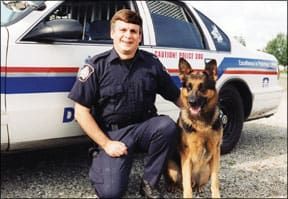
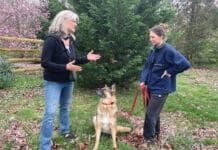



thank you for this methods!